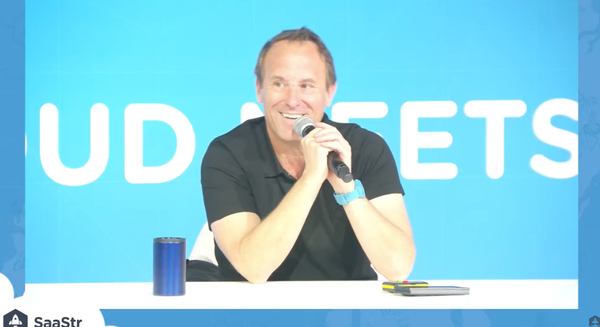SaaStr Europa 2024 Digested

If you didn't make SaaStr Europa this year, never fear! Whilst you missed out on some fantastic networking, here's a quick digest of some of the key themes from the event...
Align Product and Go-to-Market Strategy
Product Vision and Market Positioning
A seamless alignment between your product vision and GTM strategy is essential for frictionless growth. Your product's features should resonate with your marketing positioning and sales focus, ensuring that what your product team builds is precisely what your sales team sells.
"Your product strategy and your go-to-market strategy must be incredibly complementary... The tighter you can align your product vision with your marketing positioning and ultimately your sales focus, the more that you're going to be able to unlock frictionless growth."
Managing Tensions: End Users vs. CTOs
Decide whether your product primarily serves end users or decision-makers like CTOs and Heads of IT. This decision will shape your resource allocation—enhancing user-centric features or focusing on security and administrative functionalities.
"Are you building the product for end users or are you building the product for your CTO and your heads of IT?"
Balancing PLG and Traditional Sales
Choosing between a product-led growth (PLG) strategy and a traditional sales approach will significantly impact your marketing, brand positioning, and resource allocation. Consider your target market and growth goals when making this decision.
"Do you fuel your PLG motion... are you driving for revenue through self-service... versus whether you're trying to generate leads for your sales team in a B2B motion?"
Establishing Feedback Loops
Strong feedback loops are crucial. Collect feedback from social media, customer tickets, sales feedback, and direct customer interactions to continuously improve your product and align it with market needs.
"You should be creating some form of strong feedback loop... keep an eye on your Twitter feed, listen to your users with your tickets, and take information from your sales team."
Develop a Clear Go-to-Market Strategy
Strategic Planning
Utilize frameworks like the Pyramid of Clarity to build a robust strategic plan. This involves setting a compelling vision, crafting a clear and concise strategy, and linking company-wide objectives with departmental goals.
"Build a robust strategic plan... the Pyramid of Clarity... compelling vision, clear and concise strategy, and company-wide objectives tied to departmental goals."
Mapping the Customer Journey
Understanding and mapping the entire customer journey—from brand awareness to retention—is vital. Ensure all teams (marketing, sales, customer success) are optimised at each stage to provide a seamless experience.
"It's really, really important to continue to map all of those functions along what you're understanding to be your classic customer journey."
Regular Communication
Maintain regular communication with all stakeholders about progress towards key results and strategic objectives. This transparency keeps everyone aligned and focused.
"Regularly communicate key results and projects that are progressing to help drive those business objectives."
Build and Maintain a High-Performance Team
Early Team Dynamics
In the early stages, hire versatile "Jedi" team members who can handle multiple functions and adapt to changing needs. These individuals will set the foundation for your company's culture and operations.
"Hire versatile 'Jedi' team members who can handle multiple functions and adapt to changing needs."
Embracing Diversity
A team with diverse backgrounds and perspectives is more innovative and effective in problem-solving. Encourage diversity to foster a richer workplace environment.
"It's important to have a team with diverse backgrounds and perspectives to foster better problem-solving and innovation."
Promoting a Growth Mindset
Encourage continuous learning and development within your team. Implement initiatives like the 10% rule, where team members dedicate a portion of their time to learning activities.
"Promote a growth mindset within your team... Implement initiatives like the 10% rule."
Integrating Customer Success
Ensure your customer success teams are deeply integrated into the sales process, contributing actively to customer relationships and value delivery beyond just technical support.
"Ensure customer success teams are not just handling technical support but actively contributing to customer relationships and value delivery."
Optimize Marketing and Sales Channels
Investing in SEO and Content Marketing
Early investment in SEO and content marketing can yield long-term benefits. Owning valuable search terms and creating educational content will attract and retain customers over time.
"Invest in SEO and content marketing early... Owning valuable search terms and creating educational content helps attract and retain customers over the long term."
Engaging with Community and Influencers
Leverage community and influencer marketing to build brand awareness and credibility. Engage with relevant communities and use influencers to amplify your message.
"We invest heavily in our community, we invest heavily in our brand, and we invest heavily in influencers that can help distribute notion to the masses."
Balancing Revenue Streams
Strive for a balance between short-term revenue opportunities and long-term strategic growth. Focus on building sustainable relationships with enterprise clients rather than relying solely on consumer-driven self-service revenue.
"Balance short-term revenue opportunities with long-term strategic growth."
Leverage AI for Efficiency
Utilizing AI for Marketing and Sales
Leverage AI to reduce headcount and increase efficiency in marketing and sales operations. AI can automate tasks such as data scraping and content creation, driving a lower customer acquisition cost (CAC).
"The real impact is that we have more quality, better quality, and speed but for less cost... AI can scrape websites, scrape random content for extremely cheap and feed that back into AI prompts for outbound or for SEO driving an extremely low CAC on those channels."
Transitioning from PLG to Sales-Led Growth
Combine product-led growth (PLG) with traditional sales methods to scale effectively. This hybrid approach allows for broader reach and deeper engagement with enterprise clients.
"PLG motion is the right way to go because you have a product that sells itself. However, as you move out of that trap, you need to identify a champion internally and target corporate buyers."
Aligning Marketing and Sales
Ensure marketing and sales efforts are tightly integrated to optimize customer acquisition and retention. Coordinated efforts between these teams can lead to more personalized and effective engagement with prospects and customers.
"Outbound is now owned by growth and marketing teams... we can scale scraping, data building, and intense signals... sequences are dead, every new email is built purposefully based on the situation and data we aggregate."
Personalizing Customer Engagement
Use AI to create personalized and highly relevant customer interactions. This improves engagement and conversion rates by addressing specific customer needs and preferences.
"We scraped Facebook ads, understood the ads and the companies, and injected that into personalized emails recommending the right subreddits for advertising."
Conclusion
By focusing on aligning product and GTM strategy, developing a clear and integrated GTM strategy, building high-performance teams, optimising marketing and sales channels, and leveraging AI for efficiency, go-to-market leaders at B2B SaaS scaleups can drive efficient revenue growth in the second half of the year.
And if you'd like to integrate content personalisation into your prospecting to increase response rates and meetings booked, we should talk!
